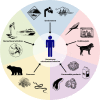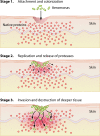The genus Aeromonas: taxonomy, pathogenicity, and infection
- PMID: 20065325
- PMCID: PMC2806660
- DOI: 10.1128/CMR.00039-09
The genus Aeromonas: taxonomy, pathogenicity, and infection
Abstract
Over the past decade, the genus Aeromonas has undergone a number of significant changes of practical importance to clinical microbiologists and scientists alike. In parallel with the molecular revolution in microbiology, several new species have been identified on a phylogenetic basis, and the genome of the type species, A. hydrophila ATCC 7966, has been sequenced. In addition to established disease associations, Aeromonas has been shown to be a significant cause of infections associated with natural disasters (hurricanes, tsunamis, and earthquakes) and has been linked to emerging or new illnesses, including near-drowning events, prostatitis, and hemolytic-uremic syndrome. Despite these achievements, issues still remain regarding the role that Aeromonas plays in bacterial gastroenteritis, the extent to which species identification should be attempted in the clinical laboratory, and laboratory reporting of test results from contaminated body sites containing aeromonads. This article provides an extensive review of these topics, in addition to others, such as taxonomic issues, microbial pathogenicity, and antimicrobial resistance markers.
Figures



References
-
- Abuhammour, W., R. A. Hasan, and D. Rodgers. 2006. Necrotizing fasciitis caused by Aeromonas hydrophila in an immunocompetent child. Pediatr. Emerg. Care 22:48-51. - PubMed
-
- Adamski, J., M. Koivuranta, and E. Leppänen. 2006. Fatal case of myonecrosis and septicaemia caused by Aeromonas hydrophila in Finland. Scand. J. Infect. Dis. 38:117-199. - PubMed
Publication types
MeSH terms
LinkOut - more resources
Full Text Sources
Other Literature Sources
Molecular Biology Databases
Miscellaneous

